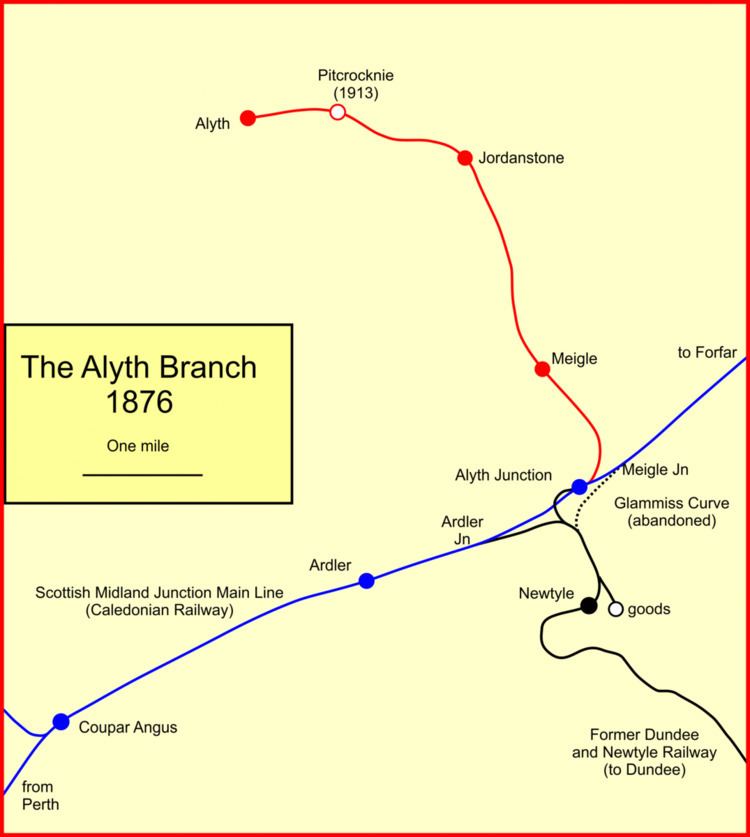 | ||
The Alyth Railway was a short branch railway line built in Strathmore in Scotland, connecting the town of Alyth to the main line network. It opened in 1861. Its junction was remote from any large population centre except Dundee, which was only reached by a primitive line with three rope worked inclines. This was modernised in 1868 and the Alyth branch, now with a good connection to Dundee, became busy. Nonetheless the population of Alyth declined, and so did usage of the line, and it closed in 1951.
Contents
History
The Scottish Midland Junction Railway opened its main line between Perth and Forfar, forming part of a network of associated companies connecting central Scotland and Aberdeen. The line ran through Strathmore and adopted and upgraded two moribund railways, the Newtyle and Coupar Angus Railway and the Newtyle and Glammiss Railway. The SMJR was amalgamated with the Aberdeen Railway in 1856, together forming the Scottish North Eastern Railway (SNER).
Promoters in Alyth saw the advantages of a railway connection, and they obtained an Act of Parliament for a branch line to their town, on 14 June 1858; the Alyth Railway company was authorised, with capital of £33,000. to build a branch line to Alyth from Meigle, a junction on the SNER main line. The branch was just over 5 miles (8 km) long.
It opened on 2 September 1861 and was worked by the SNER.
An Act of 23 June 1864 authorised the lease of the line in perpetuity to the Scottish North Eastern Railway, which had taken over the Scottish Midland Junction Railway. The lease charge was 45% of gross receipts. The SNER was itself taken over by the Caledonian Railway in 1866 and the lease transferred to the Caledonian.
The population of Alyth had been 3,422 in 1861 but this declined to 2,837 by 1921 and did not recover. Use of the line declined accordingly, and it closed to passengers on 2 July 1951. Complete closure followed in January 1965.
Topography
The point of junction with the main line was named Alyth Junction; the Dundee and Newtyle Railway had been connected to the former SMJR main line by two ancillary railways, the Newtyle and Coupar Angus Railway and the Newtyle and Glammiss Railway. (Glammiss is spelt Glamis nowadays.) These two lines approaching from Dundee forked to run south-west and north-east respectively, and Alyth Junction was in the middle of the base of the triangle. As Dundee was a significant destination from Alyth, a connecting line from Newtyle was built by the Caledonian Railway, and it was made to cross over the main line to avoid conflict with main line trains. This opened on 3 August 1868.
The typical passenger timetable gave nine return trips daily, eleven on Saturdays, with most trains proceeding to Dundee.
The original Meigle station was located at the convergence of the Newtyle and Glammiss line with the main line, but the Newtyle spur line was lifted and the station was closed; a new Meigle Junction station was opened, sited at Alyth Junction.
The Dundee and Newtyle line had been laid with stone block sleeper track to a unique gauge of 4 ft 6.5in (1,384 mm) and had three rope-worked inclines. The Caledonian Railway took over the line and modernised it, eliminating the inclines; this work was completed on 31 August 1868. By now the Caledonian had taken over the SNER as well, and commenced running through passenger trains from Dundee to Alyth, which "became a busy country terminus over the next few years".
